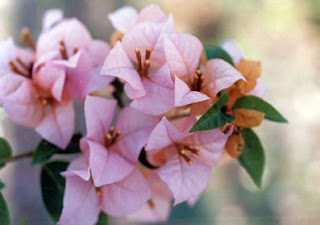 |
| Oriental lily hybrid |
Around here, it’s the height of the Oriental hybrid
season—the largest and most deeply scented of all lilies can be had for a
dollar a stem—and a stem will scent the whole house.
The way a lily scent works
is not that you necessarily notice the scent up close—the scent floats on
invisible air currents. You’ll smell lilies a floor below through an open window,
or catch a spicy/sweet breath passing a door. There is something
teasing, non-tangible, coquettish in the ways an oriental lily launches its
scent.
This is a typical hybrid with a dusting of pink freckles,
and curved petals with an amazing texture like a ginger grater or a cat’s
tongue (barbellate) the purpose of which
is collecting pollen from passing bees.
Accidental intelligence: if you get lily pollen on your
shirt or sweater, don’t rub it!
You’ll wipe in a stain. Rather, get a toothbrush or a small nailbrush and flick
the pollen off, pretending--- in Method acting mode--- you are a passing bee.
The pollen will come off without leaving a mark.
 |
| Allegretta |
If you look closely at the freckled pink hybrid, you’ll see a faint gold stripe toward
the throat. Somewhere in its parentage was the Japanese Gold-Banded lily,
notably fragrant, fall blooming, tough (once had one survive for years with no
care at all) and one of the earliest to be “discovered” by the Victorian plant
hunters. The most celebrated of the late blooming lilies and one with many hybrids.

Gold Banded Lily (lilium auratum=mountain lily)
Gold Band made its fragrant way into cultivation, probably*[i]
due to William Kerr, who was, like so many of the great plants men, a Scot, who
wandered far and wide in search of new plants.
Hawick, Scotland where Kerr was born
Colombo, Ceylon, ( 17th c.) center of the spice trade where Kerr ran the Royal Botanical garden
Kerr worked as a gardener at Kew. He caught the attention of
Joseph Banks (Remember him? Banks sent Capt. Bligh off to Tahiti.) Banks recommended Kerr be sent to the Orient
in search of plants.
Kerr went in 1804 to China, Japan, Luzon and the Philippines.
He sent back 238 plants new to the West, among them this most successful
parent, floriferous progenitor, Gold Band. He also sent back the seeds of
another great favorite—The Tiger Lily, about which more below.
Kerr’s work was so well appreciated at the time; he was sent
to superintend the opening of the royal Botanical Garden at Colombo, Ceylon and
stayed there in charge of the Garden. This was a great honor at the time for a
gardener who was not “a gentleman born.”
However, Ceylon proved too intoxicating for Kerr, who died there in 1805 of opium addiction. as reported at the time," due to a lack of experience with the drug."
Another of the wildly fragrant, "ravishing" Autumn flowering hybrid that grows easily around here is Casa Blanca:
Casa Blanca is a hybrid Oriental, blooms usually a little
earlier than the Gold Band hybrids. Easy to grow. Can grow to be 4" across. Great in large pots, in
shaded areas. It’s perhaps not as"persistent" in So Cal as the Japanese based hybrids. but planted in dappled shade
with excellent drainage it should do well. It’s vigorous, and takes very
moderate watering. (Most lilies need a lot of mulch to keep their roots cool,
but a modest amount of water.)
You can see its resemblance to Casa Blanca but the unusual cool yellow is refreshing in the late summer . Like all Orientals, it smells good.
Passing observation: if you're allergic to scent, stick to the Asiatic, early blooming lilies.
Striking a very different note in the garden are the next group, the Tiger Lilies. A neighbor has a magnificent muddle of a cottage garden with tiger lilies growing 6-8 feet tall (an eastern exposure
with roots shielded by a gigantic lace cap hydrangea)
 |
| Fortune in the center |
From R. Fortune's "A Residence Among the
Chinese", published in 1857). (See
Google data)
The plant collector extraordinaire, Robert Fortune, another
doughty Scot, disguised himself as Chinese to penetrate NW China after the
Opium Wars. (The Chinese had small use for British plant collectors for many
years after that series of events)
How did he get away with it? He spoke Chinese and had a flair....Fortune gets official credit discovery of the Tiger lily, though it’s probable that Kerr also sent back bulbs or seeds to Kew.
The Tiger lily was an enormous commercial success in Britain as it’s easy to grow there. Here in So Cal, Tiger lily and its hybrids don’t mind the alkaline soil; again give it good drainage, and dappled shade.
hybrid from http://thelilygarden.com/
 |
| Silver Scheherazade also from Lily Gardens |
.JPG) |
| Tiger lily hybrids |
Lily bulb merchants
begin shipping in October; this is a good time to order. You needn't plant the bulbs until after the New
Year in this climate. Lilies don't appreciate being planted in warm soil. Let
the ground cool off after the first heavy rain before you plant them.
Bartram listed Tiger lily in his plant catalogue by 1814 because it was spectacular," hardy, easy to propagate". Still is
Note: my discerning readers will noticed the absence of the Trumpet lilies.They bloom in mid-summer.More about them later.Having never grown them before, am planting them this winter to see how they'll do in this climate.---a hybrid variety called Flugel Horn. Who could resist?
Lilium longafolium, the Easter lily, does well and is a commercial lily in So Cal..Reported by the Pacific Bulb Society as doing well as far south as Long Beach, planted in the ground under a tree.
[i] No
one seems absolutely clear who collected the first bulbs or seeds—could have
been either Kerr or Robert Fortune, but Kerr is the most likely. Besides it’s a
remarkable story!


















2.jpg)


.JPG)

.jpg)























